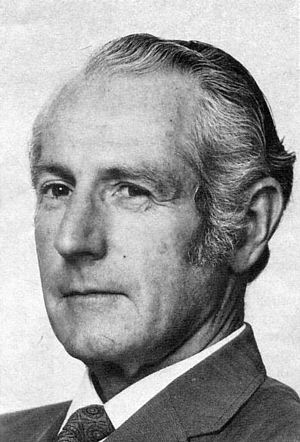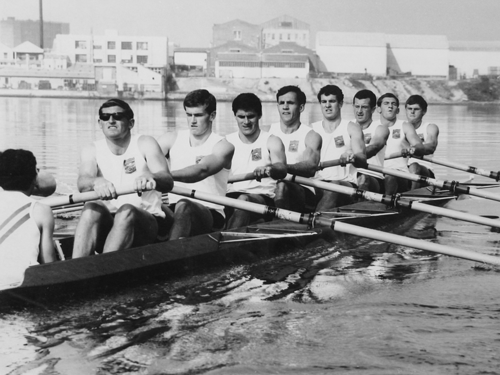Alan R Callaway

Colleagues Rowing Club then Sydney Rowing Club (NSW)
Alan was affectionately known as "the Commander" a legacy of his service in the Royal Australian Navy and Naval Reserve.
Aside from his excellence as a coach, he held several administrative positions within the NSWRA and was a keen photographer. His movies of some of his rowing tours remain and provide an excellent record of these tours.
The following excellent record of the life of Alan Callaway was written by Ian Stewart in his publication commemorating the victory of 1959 Sydney High School crew in the Head of the River coached by Alan.
Alan Callaway was born on 5 August 1917 and lived in Ocean Street, Bond with his parents, Arthur Henry and Cecilia Frances, and two older brothers. Arthur, known as ’Tod’, was a stand-up comedian with J.C. Williamson’s and Cecilia, twenty-two years his junior, was a member of a dance troupe called the ’Gaiety Six’. When Alan was eleven his father, then aged sixty, died, leaving his thirty-eight year old widow to bring up the three boys.
Alan did not begin secondary school at Sydney High but transferred there in 1930. He rowed in the High Eight in 1934 in the four seat, with Merv Wood, who rowed five in that crew. Sydney Grammar won the Eights race that year in a record time of 7:38.5. Alan sat the Leaving Certificate at the end of 1934 but returned to school in 1935 and rowed again in the Eight, this time in the six seat. That year saw the school purchase two new boats—a practice eight called the “Victor W. Hyde” and a four—the “Charles A. Fairland”. Vic Hyde was, during his relatively short tenure of the position, a much admired rowing master. The “Hyde”, the last of the cedar eights, continued until the 1956/57 season when it was used as a practice boat for the Junior Eight prior to their taking up rowing in the “Livingstone”.
After leaving school Alan enrolled in the Engineering Diploma course at Sydney Technical College. From 1936 he maintained his connection with SHS rowing and is noted in “The Record” as having acted as ‘camp supervisor’ during rowing camp. He held this position until the 1939/40 season when he began coaching Penrith crews.
In 1936, the first year the GPS Regatta was held on the Nepean River, George Hancock retired from coaching High and Bill Livingstone took over the Eight. Frank Nichols coached the First Four and Des Duffy the Seconds, Thirds and Fourths. When Livingstone left in 1939 Frank Nichols took over the Eight. Des Duffy and Stan Wick, the rowing master, coached the Fours. 1940 saw Nichols in charge of the Eight, Duffy the First and Second Fours and Alan Callaway the Thirds and Fourths.
At this point World War II began to impact on GPS and SHS rowing. Des Duffy left for overseas service with the A.I.F., later to be taken prisoner in Singapore at the ‘Fall’ in 1942. Alan entered service with the RAN on 15 April 1941. Frank Nichols remained at the coaching helm and was assisted by Kevyn Webb, later to be an Commonwealth Games bronze medallist.
Alan’s entry into the RAN was prompted in part by the fact that he had two older brothers already serving in the Navy. In addition his engineering knowledge, especially in relation to the developing techniques of radar, caused the authorities to channel him in that direction. He began as a sublieutenant in the Royal Australian Naval Reserve in 1941 and sailed for England on the “Brisbane Star” in November of that year. On his twenty-fifth birthday he was promoted to the rank of Lieutenant. He served at various depots including HMS “Orlando”, a shore-based establishment related, among other things, to the development of radar, and HMS “Mercury”, also known as S.C.U. or Special Communications Unit. He then went to sea and served in destroyers, including HMS “Antelope”, on convoy protection duty in the Atlantic. After the fall of Singapore, Alan transferred to the RAN and to heavy cruisers, including HMAS “Australia” and HMAS “Shropshire”. This latter vessel, a County Class heavy cruiser of 9850 tons, originally of the Royal Navy and commissioned in 1929, saw action in the Atlantic during 1942. After the sinking of the HMAS “Canberra” during the Battle of Savo Island in August 1942 the “Shropshire” was transferred to the Royal Australian Navy as a replacement, arriving in Sydney on 2 October 1943. With Lieutenant Callaway aboard as an officer in communications, with responsibility for radar operation, the “Shropshire” sailed for New Guinea waters where she saw action in the Battle of the Coral Sea. During this conflict “Shropshire” came under intense bombardment by Japanese kamikaze planes on several occasions but was fortunate to avoid a direct hit, once being showered with debris from a kamikaze which had been destroyed by fire from HMAS “Gascoyne” as the aircraft was about to plunge into “Shropshire”. During this period the radar operators on Shropshire” were able, with their superior technology, to provide the US Navy with advance information, thus avoiding significant extra loss. For his part in this period of conflict Alan was awarded a ‘Mentioned in Dispatches’.
Because of his special engineering background, Alan was de-mobilized on 24 October 1945 at the request of the Australian Director General of Manpower so that he could resume his former occupation. As mentioned, his original engineering qualification had been obtained through Sydney Technical College. At the time he left Australia for war service in Britain, Alan was part-way through a Town and Country Planning course. On demobilization he resumed his studies and gained the Diploma soon after. As a civilian he began work with the Cumberland County Council and later transferred to the Department of Main Roads as a civil engineer and town planner, working with the DMR until retirement. On leaving the DMR Alan and his wife Hilda moved from the long-standing family home in Dover Heights to a unit in Drummoyne with a view over the river and towards Cockatoo Island.
However, he did not sever his connection with the Navy, remaining in the RANR. In 1950 he was promoted to Lieutenant Commander and then to Commander during the 1960s, being the first naval reservist to achieve such rank. He was made, during the 1964 Royal visit, Aide de Camp to the Queen.
In 1945, once back in Australia, Alan was able to resume his SHS rowing coaching. With Des Duffy still out of the country, having been a prisoner-of-war of the Japanese since the Fall of Singapore, Alan took over the coaching of all Fours while Frank Nichols continued with the Eight. When Des Duffy returned to Sydney he resumed his coaching role with the First and Second Fours, leaving Alan to take charge again of the junior Penrith crews.
From the late 1940s the school entered a period of Penrith success. The 1947 Second Four started a string of four consecutive wins. In 1948 and ‘49 there were consecutive Yaralla Cup wins, as well as a Major Rennie Trophy in 1948. 1953 saw wins by the Eight and by the First Four which was coached by Alan. Frank Nichols retired from coaching at SHS after the 1956 regatta and Alan took over the Eight with Graham Pilger in charge of the First Four and Dick White the Seconds. Both of these coaches had been High oarsmen in the late ‘40s and early ‘50s.
Immediately Alan had success with the 1957 Eight, a crew of boys with considerable prior regatta experience. The unlucky 1958 crew, which lost its stroke, Peter Phillips, due to injury only weeks before the Head of the River race, still managed a third place. The wins in 1958 by the First and the Second Fours bode well for the 1959 season. Predictions were made about a big and experienced crew—which the 1959 boys were—and these came true with a two-length , near record win on 18 April 1959.
After the 1959 racing season moves were made to form a new rowing club, using as its nucleus the rowers from the successful 1957 and 1959 crews, together with some other former GPS oarsmen. The club became known as Colleagues’ Rowing Club. At first boating from SHS and then from Riverview’s clubhouse, Colleagues RC established itself a boathouse in Tambourine Bay on the Lane Cove River.
Among the successes of this first Colleagues’ crew was the 1960 Riverview Gold Cup and the 1960 State Junior Eight’s Championship. The club, during its relatively short life of four years, from 1960 to 1968, had further success in winning the NSW Senior Eights Championship in 1961 and 1963 and the 1962 NSW Coxed Four Championship. In 1961 Alan coached the State Eight for the Kings Cup race and repeated this endeavour in 1963. Several Colleagues members were in each of these crews.
By 1968 Colleagues RC had disbanded and Alan began coaching at Sydney RC. That year the NSW State Eight was being coached by Phil Cayzer but his firm, Dulux, decided to send him to America for a year. Alan Callaway was invited to take his place. The crew won the Kings Cup by a second from the Victorians. This put Alan in the position of becoming coach of the Australian Eight to contest the Olympics in Mexico in 1968. The events, conducted at an altitude of 2225 metres, proved gruelling. In spite of this the Australian Eight lost the gold medal to Germany by a mere two feet!
Alan’s international career in coaching continued with the 1972 Munich Games. Almost simultaneous with the murderous attack by Black September on the Israeli athletes, housed next to the Australians, Alan was taken ill with a perforated duodenal ulcer. It was not until the following day that his family in Australia heard the relieving news that he was not in hospital because of gunshot wounds!
Ill health continued to trouble Alan but he continued his coaching on into the seventies. His last crew—a Sydney RC four—had raced in Adelaide in 1978 and he had been down to see them compete. On his return to Sydney he stepped from the aircraft and immediately collapsed on the tarmac. It was apparent that he had suffered a fatal coronary event and was dead on arrival at hospital.
Alan’s departure at the relatively early age of sixty one left a large gap in the rowing scene in Sydney. Wherever he went and whomever he coached, he was greeted with success. Those of the two GPS Head of the River Eights he coached will always remember him as a cool tactician who planned well and raised his crews to their maximum performance. This was clearly also the case with the 1968 Olympic crew who came within an ace of the gold medal. Many others at all levels of rowing who knew him regard him not only as a calm and determined coach but always as a gentleman. We honour his memory.
Known major rowing record
1961 - Interstate Men's Eight Championships coach - Second
1963 - Interstate Men's Eight Championships coach - Second
1966 - Interstate Men's Eight Championships coach - Second
1966 - World Championships - Men's Coxed Four coach - Eighth
1968 - Olympic Games - Men's Eight coach - Silver
1968 - Interstate Men's Eight Championships coach - First
1972 - Olympic Games - Men's Eight coach - Eighth
1972 - Interstate Men's Eight Championship coach - First
1973 - Interstate Men's Eight Championship coach - Fourth
1973 - Interstate Men's Pair Championship coach - First & Second
1977 - World Championships - Men's Eight coach - Eleventh

1968 Silver Medal Winning Eight
Andrew Guerin 2017
Updated December 2023 with a substantial contribution from Ian Stewart

